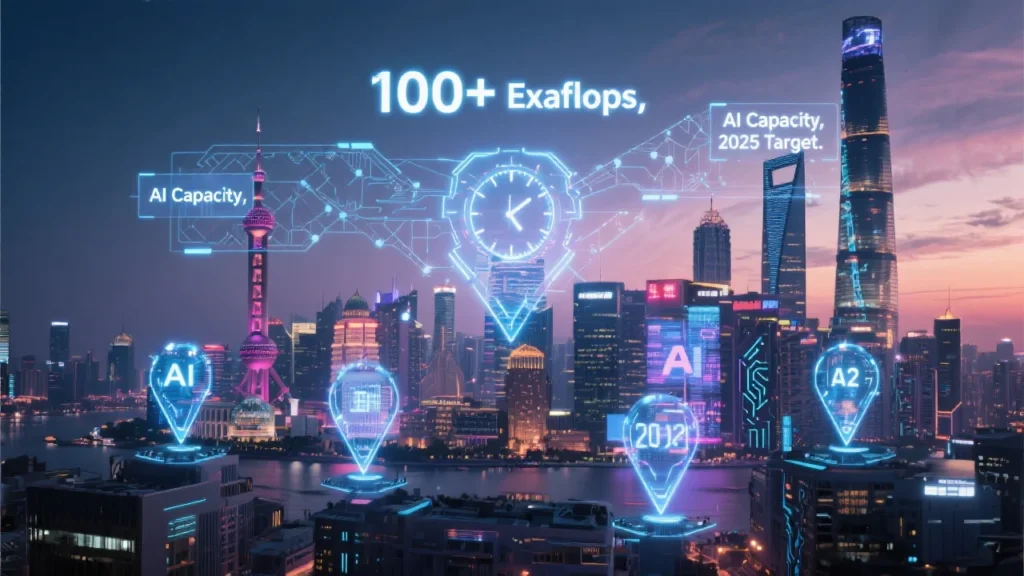Shanghai is making a bold move to cement its position as China’s artificial intelligence powerhouse. The city has announced plans to complete at least five new large-scale data centers by the end of 2025, marking a significant acceleration in China’s digital infrastructure development.
This ambitious initiative comes as China races to strengthen its AI capabilities amid growing global competition. The expansion is expected to push Shanghai’s AI computing capacity beyond 100 exaflops, according to a recent plan from the Shanghai Communications Administration made public in August 2025.

Understanding the Scale of Shanghai’s AI Ambitions
To put this achievement in perspective, an exaflop represents one quintillion floating-point operations per second. This massive computational power will position Shanghai as a major player in the global AI landscape. Currently, China’s total computing power reached 246 exaflops as of June 2024, placing the nation second only to the United States.
The timing of Shanghai’s announcement is particularly significant. Since DeepSeek introduced its groundbreaking open-source reasoning model in January 2025, China has experienced what Moody’s Ratings describes as “a new wave of data centre construction across the country.” This development has fundamentally shifted the AI landscape, proving that high-performance models can be built more efficiently than previously thought.
China’s Data Center Market Dominance
The broader context reveals China’s commanding position in the Asia-Pacific data center market. According to industry analysts, China is expected to remain the largest data center market in the Asia-Pacific region, with growth projected to accelerate at about 20 percent annually through 2030. This growth trajectory is supported by strong policy backing and increased government support for domestic operators.
Shanghai’s initiative exemplifies how local governments across China are driving AI infrastructure development. The city’s strategic approach reflects a coordinated national effort to build the computational backbone necessary for AI advancement.
The DeepSeek Effect on Infrastructure Demand
The emergence of DeepSeek’s reasoning model has created ripple effects throughout China’s AI ecosystem. This breakthrough has demonstrated that sophisticated AI capabilities can be achieved with more efficient resource utilization, potentially changing how data centers are designed and operated.
However, this efficiency gain hasn’t reduced the overall demand for computing infrastructure. Instead, it has sparked renewed interest in AI development across various sectors, creating sustained demand for data center capacity. The success of DeepSeek has encouraged more companies to pursue AI initiatives, driving the need for robust computational infrastructure.
Innovative Approaches to Data Center Development

China is pioneering innovative solutions to address the growing demand for AI infrastructure. One particularly fascinating development is the country’s exploration of underwater data centers. China is putting data centers in the ocean to keep them cool, with a wind-powered underwater facility currently under construction about six miles off Shanghai’s coast.
This underwater data center represents a bold approach to sustainable computing infrastructure. The facility uses seawater for natural cooling, potentially reducing electricity consumption by at least 30 percent compared to traditional land-based centers. The project is designed to be powered by 97 percent renewable energy from nearby offshore wind farms.
Challenges in China’s Data Center Boom
Despite the ambitious expansion plans, China’s data center industry faces significant challenges. Recent reports indicate that many newly built AI data centers across China are sitting empty, with up to 80 percent of newly constructed computing resources remaining unused.
This situation has emerged from a combination of factors. The rapid construction boom was often driven by speculative investment rather than actual demand. Many projects were led by companies with limited AI expertise, resulting in facilities that don’t meet current technical requirements.
The shift toward reasoning models like DeepSeek’s R1 has also changed infrastructure needs. These models require different hardware configurations optimized for inference rather than training, making some existing facilities less suitable for current AI applications.
Economic and Strategic Implications
Shanghai’s data center expansion reflects broader economic and strategic considerations. As China’s real estate sector experiences a downturn, local governments are seeking alternative growth drivers. AI infrastructure has become an attractive option for stimulating economic development while building strategic capabilities.
The initiative also represents China’s commitment to technological self-reliance. By building robust domestic AI infrastructure, the country aims to reduce dependence on foreign technology and create a foundation for indigenous innovation.
Major Chinese technology companies are aligning their investments with these national priorities. Alibaba Group has announced plans to invest over $50 billion in cloud computing and AI hardware infrastructure over the next three years, while ByteDance plans to invest around $20 billion in GPUs and data centers.
Global Competition and Market Dynamics
Shanghai’s expansion occurs against the backdrop of intense global competition in AI infrastructure. Goldman Sachs Research forecasts that global power demand from data centers will increase 50% by 2027 and by as much as 165% by the end of the decade.
In the United States, major technology companies are pursuing similar large-scale infrastructure projects. The Stargate initiative, involving OpenAI, SoftBank, and Oracle, plans to invest up to $500 billion over four years to build advanced data centers and computing infrastructure.
This global race for AI infrastructure supremacy underscores the strategic importance of computational capacity in determining technological leadership. Countries and companies that can build and operate large-scale AI infrastructure will likely have significant advantages in developing and deploying advanced AI systems.
Environmental Considerations and Sustainability
The massive scale of data center expansion raises important environmental questions. Traditional data centers consume enormous amounts of electricity and water for cooling. Shanghai’s embrace of innovative solutions like underwater data centers demonstrates awareness of these challenges.
The underwater facility off Shanghai’s coast represents a potential model for sustainable AI infrastructure. By using natural seawater cooling and renewable energy, such facilities could significantly reduce the environmental impact of large-scale computing operations.
However, environmental concerns remain. Underwater data centers can cause localized warming of seawater and may impact marine ecosystems during heat waves. Balancing rapid infrastructure development with environmental responsibility will be crucial for sustainable AI growth.
Future Outlook and Market Implications
Shanghai’s ambitious data center expansion plan signals confidence in the long-term growth of AI applications. Despite current challenges with underutilized facilities, the city’s leadership believes that demand will eventually catch up with supply.
The success of this initiative will likely influence similar projects across China and globally. If Shanghai can effectively deploy and utilize its expanded AI infrastructure, it could serve as a model for other cities seeking to build AI capabilities.
The project’s outcome will also impact global AI competition. Enhanced computational capacity in Shanghai could accelerate Chinese AI development, potentially affecting the global balance of AI capabilities and innovation.
As the AI industry continues evolving rapidly, Shanghai’s data center expansion represents a significant bet on the technology’s future. The city’s ability to successfully implement and utilize this infrastructure will play a crucial role in determining China’s position in the global AI landscape.
The initiative reflects broader trends in AI infrastructure development, where countries and regions are making substantial investments to secure their technological futures. Shanghai’s ambitious plan demonstrates the scale of commitment required to compete in the AI era.
Sources
- Shanghai targets 5 new data centres in 2025 as China boosts AI computing capacity | South China Morning Post
- China Powers AI Boom with Undersea Data Centers | Scientific American
- China built hundreds of AI data centers to catch the AI boom. Now many stand unused. | MIT Technology Review
- AI to drive 165% increase in data center power demand by 2030 | Goldman Sachs










Comments 1